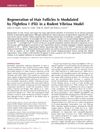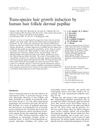In Search of the Common Mechano-Chemical Pathways During the Regeneration of Spiny (Acomys Cahirinus) and Laboratory (Mus Musculus) Mouse Skin
skin regeneration hair bulges stem cell marker collagen III collagen I RNA-seq epithelial-to-mesenchymal transition cell proliferation matrix remodeling tissue stiffness wound-induced hair neogenesis transcription factors hair regeneration mechano-chemical pathways skin repair hair growth stem cells collagen gene expression cell growth tissue remodeling optimal stiffness hair growth from wounds gene regulators hair growth pathways
TLDR Spiny mice regenerate skin better than laboratory mice due to larger hair bulges, more stem cells, and different collagen ratios.
The study compared the skin regeneration abilities of African spiny mice (Acomys cahirinus) and laboratory mice (Mus musculus) following large full-thickness wounds. Spiny mice exhibited robust regenerative abilities, while laboratory mice regenerated some hairs from the wound center. Key differences included larger hair bulges and higher stem cell marker expression in spiny mice, as well as a higher collagen III to I ratio in their wounds. RNA-seq analysis revealed upregulation of genes related to epithelial-to-mesenchymal transition, cell proliferation, and matrix remodeling in both species. Optimal tissue stiffness for wound-induced hair neogenesis was identified at 5-15 kPa. Manipulating upstream transcription factors altered hair regeneration outcomes, providing insights into the mechano-chemical pathways of skin repair and regeneration.



